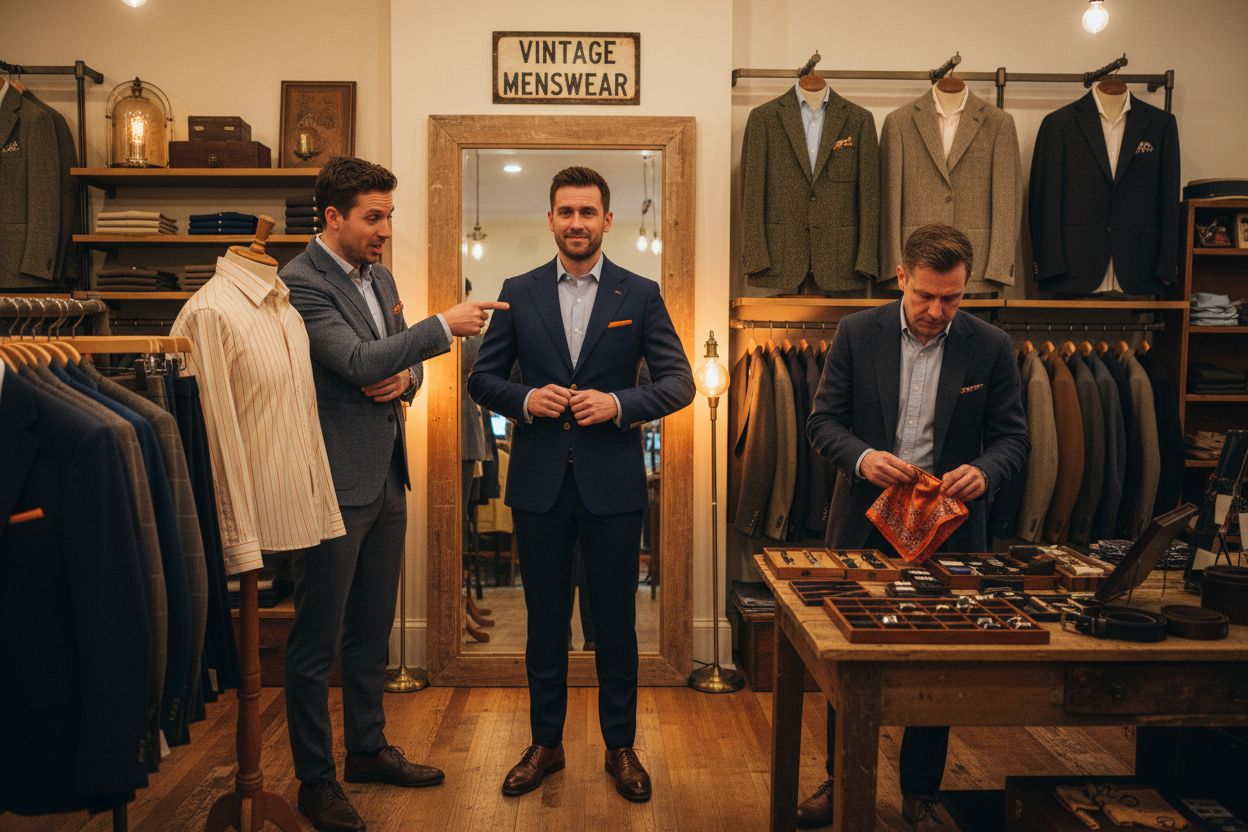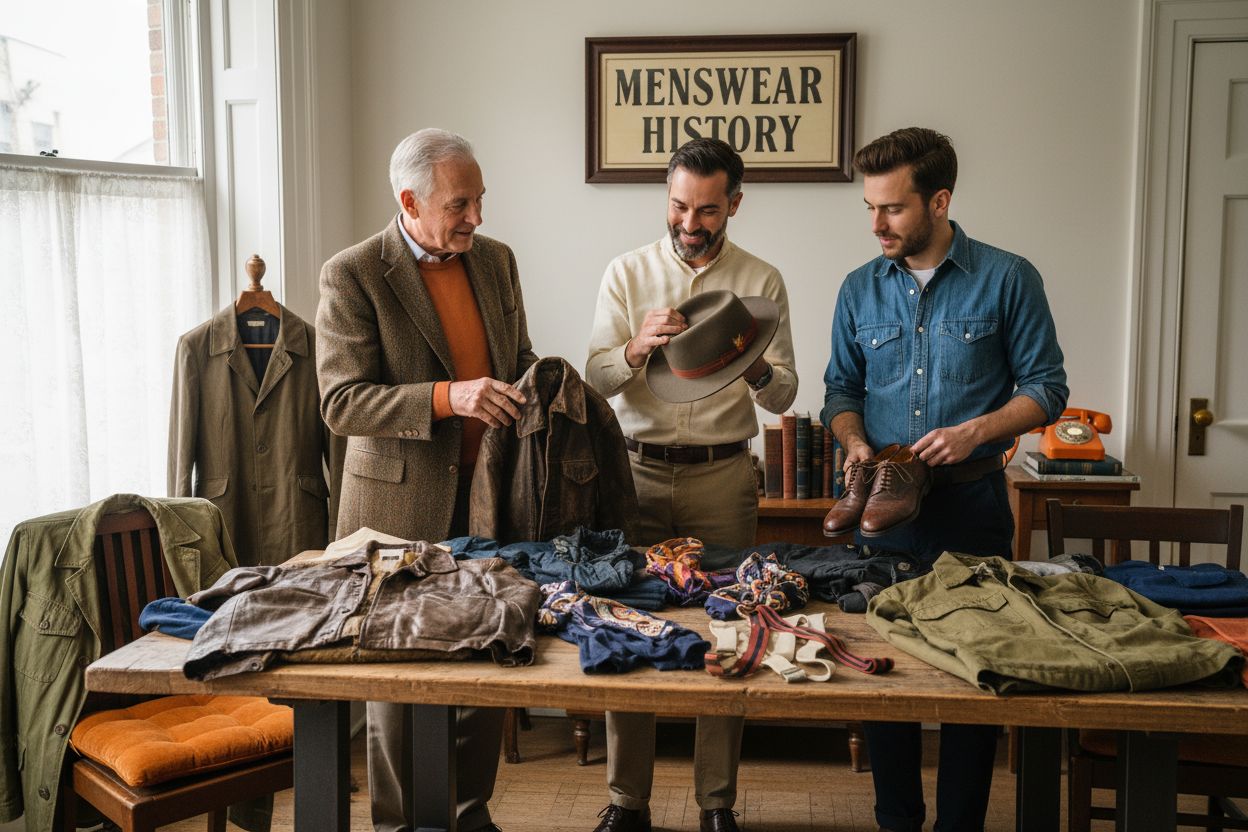What is Vintage Menswear? The Charm and Impact
- Emma

- Oct 6
- 9 min read

Vintage menswear might look like a collection of old jackets and trousers but there is far more beneath the surface. Modern wardrobes are often filled with clothing that lasts just a season yet authentic vintage menswear refers to garments at least 20 to 25 years old, each piece woven with stories and skilled craftsmanship often missing from today’s high street finds. Most people see these as throwbacks but they are actually historical records you can wear right now.
Table of Contents
Quick Summary
Takeaway | Explanation |
Vintage menswear is 20-25 years old | Authentic vintage garments are defined as being from specific eras, at least 20-25 years old, reflecting intricate fashion history. |
Focus on craftsmanship and authenticity | Look for hand-stitched details and high-quality fabrics, which distinguish vintage pieces from modern mass-produced garments. |
Vintage fashion promotes sustainability | Purchasing vintage reduces textile waste, minimises carbon emissions, and challenges the fast fashion cycle, making it an eco-friendly choice. |
Collecting requires historical knowledge | To build a significant vintage collection, one must understand garment provenance, material quality, and historical context of styles. |
Modern fashion draws from vintage styles | Contemporary designers continuously reinterpret vintage elements, showing that vintage menswear influences and shapes current fashion trends. |
Defining Vintage Menswear: Key Characteristics
Vintage menswear represents a nuanced and dynamic realm of fashion that transcends mere clothing, embodying historical narratives, craftsmanship, and individual expression. Unlike contemporary mass-produced garments, vintage menswear captures the essence of bygone eras through meticulously crafted pieces that tell stories of cultural and sartorial evolution.
The Authenticity of Age and Provenance
At its core, vintage menswear is defined by specific temporal and qualitative characteristics. Authentic vintage clothing typically refers to garments that are at least 20-25 years old, originating from specific historical periods such as the 1940s, 1950s, or 1960s. These pieces are not merely old clothes but represent tangible artifacts of fashion history.
Key distinguishing features include:
Original construction techniques: Hand-stitched details, unique buttonholes, and precision tailoring
Fabric quality: Superior natural materials like wool, cotton, and silk
Distinctive design elements: Period-specific cuts, patterns, and styling
For those eager to explore more about historical menswear styles, our comprehensive guide to vintage suits offers deeper insights into the rich tapestry of men’s fashion evolution.
Craftsmanship and Cultural Significance
Vintage menswear is not simply about aesthetic appeal but represents a profound connection to cultural and artisanal traditions. Each garment embodies the manufacturing techniques, social contexts, and design philosophies of its respective era. From meticulously tailored suits of the mid-century to rugged workwear from industrial periods, these pieces reflect more than fashion—they are historical documents woven into fabric.
Understanding vintage menswear requires appreciating its multifaceted nature: a blend of historical authenticity, exceptional craftsmanship, and personal storytelling.
To clarify the differences between modern, vintage, and reproduction menswear, the following table compares their defining characteristics and qualities.
Type of Menswear | Age/Origin | Construction & Materials | Design Elements | Cultural Value |
Vintage | 20-25 years old or more | Superior natural fabrics, hand-stitched | Period-specific, distinctive | High – historical and artisanal |
Modern (High Street) | Recent, typically within 0-5 years | Often mass-produced, synthetic blends | Trend-driven, seasonal | Low – minimal historical connection |
Reproduction | Newly made in vintage style | Varies, can include modern shortcuts | Mimics vintage, not original | Medium – style imitation |
The Cultural Significance of Vintage Menswear
Vintage menswear extends far beyond fashion, serving as a powerful lens through which we can examine social, economic, and cultural transformations. These garments are not merely clothing but living historical narratives that capture the zeitgeist of their respective eras, revealing profound insights into masculinity, societal norms, and individual expression.
Historical Narrative and Social Commentary
Each vintage piece tells a complex story about the period it represents.
From the structured suits of post-war Britain symbolising restoration and propriety, to the rebellious leather jackets of the 1950s representing youth counterculture, vintage menswear reflects shifting social dynamics. The clothing becomes a material document of generational changes, demonstrating how men’s fashion has been a subtle yet potent form of cultural communication.
Key societal reflections in vintage menswear include:
Working class identity: Robust workwear representing industrial heritage
Social mobility: Changing suit styles indicating economic progression
Subcultural movements: Clothing as a form of political and personal statement
Our comprehensive guide to vintage menswear trends provides deeper exploration of these fascinating transformations.
Craftsmanship and Cultural Preservation
Beyond aesthetic appeal, vintage menswear represents an important mechanism of cultural preservation. According to the British Council’s research on menswear heritage, these garments document traditional craftsmanship techniques that are increasingly rare in contemporary mass production. Each hand-stitched seam, carefully selected fabric, and meticulously constructed garment represents a commitment to quality that transcends mere clothing.
Vintage menswear allows modern wearers to connect with historical craftsmanship, celebrating the skills of tailors, designers, and artisans who shaped fashion through decades of social transformation. By wearing these pieces, individuals do more than make a style statement—they become custodians of cultural memory, preserving and celebrating the rich tapestry of men’s fashion history.
Sustainability and Vintage Fashion: An Eco-Friendly Choice
Vintage fashion represents more than aesthetic charm—it is a powerful sustainable alternative to contemporary fast fashion, offering profound environmental and ethical benefits. By choosing vintage menswear, conscious consumers actively participate in reducing textile waste, minimising carbon emissions, and challenging the unsustainable production cycles of modern clothing manufacturing.
Environmental Impact of Vintage Clothing
The fashion industry is a significant global polluter, with rapid clothing production contributing substantially to environmental degradation. Vintage menswear disrupts this destructive cycle by extending the lifecycle of existing garments, preventing perfectly functional clothing from ending up in landfills. Each vintage piece represents a direct reduction in textile waste and a meaningful statement against the disposable fashion culture.
Key environmental advantages include:
Reduced manufacturing emissions: No new production required
Lower water consumption: Reusing existing garments saves significant water resources
Minimised textile waste: Preventing clothing from entering landfill systems
Our comprehensive guide to sustainable vintage fashion provides deeper insights into these ecological benefits.
Ethical Consumption and Resource Conservation
According to the Ellen MacArthur Foundation’s research on circular fashion, vintage clothing represents a critical strategy in developing more sustainable consumption patterns. By purchasing pre-existing garments, consumers actively challenge the linear ‘take-make-dispose’ model of contemporary fashion, instead embracing a circular economy approach that prioritises reuse, repair, and long-term value.
Vintage menswear is not just a fashion choice—it is a conscious commitment to environmental stewardship.
The following table outlines key environmental and ethical advantages of choosing vintage menswear over conventional fast fashion as mentioned in the article.
Sustainability Aspect | Vintage Menswear | Contemporary Fast Fashion |
Manufacturing emissions | None – reuses existing clothes | High – requires new production |
Textile waste | Minimal – extends garment lifecycle | Significant – frequent disposal |
Water consumption | Low – no new fabric production | High – fabric manufacturing demand |
Ethical consumption | Supports reuse, challenges fast fashion | Encourages overproduction |
Cultural preservation | Maintains historical craftsmanship | Rarely preserves tradition |
Collecting Vintage Menswear: Tips and Insights
Collecting vintage menswear is an art form that combines historical appreciation, personal style, and meticulous research. Unlike contemporary fashion acquisitions, vintage collecting requires a nuanced understanding of garment provenance, condition assessment, and historical context. Each piece represents not just a clothing item, but a tangible fragment of sartorial history.
Identifying Authentic Vintage Pieces
Authenticity is paramount in vintage menswear collecting. Discerning collectors develop a keen eye for distinguishing genuine vintage pieces from modern reproductions. Key indicators of authenticity include construction techniques, fabric composition, and manufacturing labels. Understanding the subtle details that define different historical periods becomes crucial in building a meaningful collection.
Critical aspects of vintage identification include:
Fabric and textile analysis: Examining weave, material composition, and wear patterns
Label and manufacturing details: Researching historical brand markers and production techniques
Period-specific design elements: Recognising unique stylistic characteristics of different decades
Our comprehensive guide to vintage menswear basics provides deeper insights into these identification techniques.
Preservation and Care Strategies
According to textile conservation experts at the Victoria and Albert Museum, proper preservation is essential for maintaining the integrity of vintage garments. Each piece requires careful handling, appropriate storage, and periodic maintenance to prevent deterioration. Collectors must become part conservator, part historian, understanding the delicate balance between wearing and preserving these historical artefacts.
Vintage menswear collecting transcends mere fashion acquisition—it is a passionate dialogue with history, a method of preserving cultural narratives through carefully curated textile memories.

Each garment tells a story, waiting to be understood, appreciated, and carefully maintained by those who recognise its inherent value beyond mere fabric and thread.
Influence of Vintage Styles on Modern Fashion Trends
Vintage menswear is not a static museum artifact but a dynamic force continuously reshaping contemporary fashion landscapes. Modern designers consistently draw inspiration from historical silhouettes, textile techniques, and cultural expressions embedded in vintage clothing, creating a powerful dialogue between past and present style narratives.
Cyclical Nature of Fashion Design
Fashion operates in cyclical patterns, with vintage aesthetics perpetually influencing and reinterpreting contemporary design. Designers do not merely copy historical styles but deconstruct and reimagine vintage elements, transforming traditional garment construction into innovative modern statements. This continuous reinterpretation ensures that vintage menswear remains a living, breathing cultural language rather than a static historical reference.
Key modes of vintage influence include:
Silhouette revival: Reintroducing historical cuts and proportions
Textile reinterpretation: Modern fabrics echoing vintage textures
Colour palette inspiration: Drawing from historical colour combinations
Our comprehensive guide to understanding vintage style influences provides deeper insights into these transformative processes.
Contemporary Runway and Street Style Dialogues
According to fashion historians at the Victoria and Albert Museum, vintage styles function as a continuous creative ecosystem. Contemporary designers actively engage with historical garment archives, extracting design principles that challenge and expand current fashion boundaries. Modern menswear has become a sophisticated conversation between historical craftsmanship and contemporary innovation, where vintage elements are not nostalgic relics but active design components.
This ongoing creative exchange demonstrates that vintage menswear is not about replicating the past, but about understanding historical design languages to create forward-looking, meaningful fashion expressions that honour craftsmanship while pushing creative boundaries.
Discover Authentic Vintage Menswear Crafted for Individuality and Sustainability
Are you searching for vintage menswear that matches your personal style and upholds true historical significance? The article explores the charm and cultural impact of vintage pieces, but finding genuine, expertly curated items can still feel challenging. Fast fashion lacks soul, and reproductions miss the magic. If you value authenticity, quality craftsmanship, and conscious fashion choices, your solution awaits.
At My Vintage, you will uncover a hand-picked collection of men’s clothing from the 1940s through the 1990s, each with real provenance and distinctive detail. Every piece is carefully sourced to reflect the spirit of the era, offering you the artistry and sustainability that modern apparel simply cannot replicate. Take the next step and explore our vintage menswear basics guide or browse our main shop for exceptional finds. Choosing now means you claim unique style, reduce environmental impact, and secure pieces with a story all their own.
Frequently Asked Questions
What defines vintage menswear?
Vintage menswear is defined as garments that are typically 20-25 years old, showcasing original construction techniques, high-quality fabrics, and distinctive design elements from specific historical periods. These pieces are not only garments but also tangible artifacts of fashion history.
Why is vintage menswear considered more sustainable?
Vintage menswear is considered sustainable as it extends the lifecycle of existing clothing, reducing textile waste and the environmental impact associated with new clothing production. By choosing vintage, consumers help minimise carbon emissions and challenge fast fashion practices.
How can I identify authentic vintage menswear?
To identify authentic vintage menswear, look for key indicators such as original construction techniques, the quality of fabric, and historical manufacturing labels. Examining details like stitching, material composition, and unique design elements relevant to different decades is essential for discerning authenticity.
What impact does vintage menswear have on modern fashion trends?
Vintage menswear significantly influences modern fashion trends by providing inspiration for contemporary designers. Historical silhouettes, textile techniques, and colour palettes from the past are continually reimagined and incorporated into today’s fashion, creating a dynamic dialogue between historical and contemporary styles.
Recommended







Comments